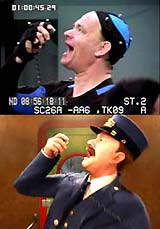
Leslie A. Kurtz September 2005 Digital technology is revolutionizing our ability to manipulate, change and recreate images. We can create new images digitally and we can scan existing film and photographs and record them in digital form. Sound can also be digitized. Once digitally captured material exists, whatever its source, it can be changed in ways not achievable in an analog world. This makes it possible to create digitally created human actors or synthespians. It may not be possible to create digital actors in all their full humanity. It is difficult to model the structure and function of facial muscles to allow for convincing dramatic performances, especially when the camera focuses in on an actor’s face its soul. We look at other people all the time, and are familiar with the way they move and behave. We know how their hair, skin and eyes look and move and reflect the light. In a recent study, researchers showed real and digital faces to volunteers to see if they could tell the difference; the volunteers were not fooled. Digital actors, however, are useful creatures today, and will become more so with the passage of time and the continued development of technology. Films can be populated with legions of digital extras. Filmmakers can use a few extras, changing eye color, hair tint, skin tone, and clothing, and create what appears to be a vast crowd with apparently infinite variations.6 Digital actors can perform stunts that would be dangerous or impossible for a live actor, perhaps eliminating the need for stuntmen and women. Digital technology can take viewers “to places no real actor, or camera setup, could go.” Digital children will not be limited by child labor laws. Wrinkles can be smoothed from or added to a face, allowing the same actor to play a character from youth through old age. Brad Pitt at 60 could perform as Brad Pitt at 20. Anthony Hopkins could play Richard Nixon, looking exactly like Nixon. Dead actors could be returned to life to play new roles in new projects with new co-stars. Marilyn Monroe and Russell Crowe could co-star in a new film. It has been suggested that John Wayne be re-animated. “There is believed to be a great deal of interest in modernizing the western genre while using hardy perennials like Wayne to lend gravitas.” Digitally created characters may become sufficiently realistic to share the screen with live performers. What is the legal status of these electronic actors—these digital human actors? Unlike traditional cartoon characters, like Mickey Mouse, they are derived in some fashion from human beings. But they are created, in large part, by those employing digital technology. Who owns legal rights to these hybrid creations? Performers and their heirs may be entitled to protection against the creation or re-use of a digital actor embodying elements of the performer’s identity. The most likely doctrine to provide this protection is the right of publicity, a matter of state law. Although the right of publicity varies widely from state to state, it generally protects against the appropriation of the commercial value of a person’s identity. It allows an individual, particularly a celebrity, to control the commercial value of his name and likeness and, in some states, other indicia of identity. Much has been written about digital actors and the right of publicity. The focus of this article, the effect of copyright on their creation and protection, has received less attention. Unlike the right of publicity, copyright will ordinarily belong to those employing digital technology to create a digital actor, and to those who created any preexisting copyrighted works used in her creation. Part I of this article will look at digital actors in terms of three paradigms derived from recent films, providing an understanding of some ways in which digital characters can be created and used. The first is the The Polar Express, which used a technique called motion or performance capture for all its characters. The second includes two films, Spider Man 2, which created digital doubles for Tobey Maguire and Alfred Molina, and Lemony Snicket’s A Series of Unfortunate Events, which created a digital double for the baby, Sunny. The third is the film Simone, in which a fictional director creates (fictionally) a digital actress. Part II will focus on copyright issues that may arise in the course of creating a digital actor. Part III will look at the way in which copyright can be used to protect a digital actor once she has been created. Digital Actors and Copyright - Part One
|